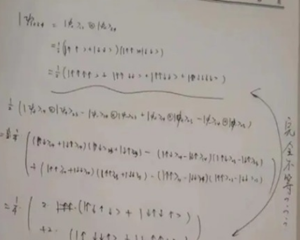In December, a sophomore electronics major going by the alias Mu Qing was doing physics homework when he discovered an error in the last equation on page 11 of the scientific background report on the 2022 Nobel Prize in Physics, according to Tsinghua University.
据清华大学透露,去年12月,电子系大二学生木清(化名)在做物理作业时,发现2022年诺贝尔物理学奖科学背景报告第11页最后一个公式出现了错误。
The equation was about quantum entanglement.
这是个关于量子纠缠的公式。
The correct equation should have positive signs for all four factors on the right side of the equation, instead of two positives and two negatives, as was shown in the report.
正确的公式右边四项应该都取正号,而不是报告中显示的两正两负。
Mu was perplexed at first. After all, he thought he was just a newcomer to physics who had the gall to question the highest authority in the field.
木清一开始很困惑。毕竟,他认为自己只是物理学的“小白”,怎么敢质疑该领域的最高权威。
Moreover, the erroneous labeling was inconsequential, since it didn't affect the conclusion of the calculation.
此外,公式符号出错并无太大问题,因为不会影响到计算的结论。

But the error kept gnawing at his mind, so Mu asked his professor Wang Xiangbin for help.
但这个错误一直在折磨着木清,于是他向教授王向斌求助。
Instead of being dismissive of the inquiry, Wang patiently tackled the problem with Mu late into the night.
王向斌并没有无视木清的疑惑,而是耐心地和他探讨这个问题,一直到深夜。
After several rounds of calculations, they confirmed that the Nobel committee had made a mistake.
经过几轮演算,他们确认诺贝尔奖委员会确实犯了错误。
Wang later presented the correction to the Royal Swedish Academy of Sciences.
随后,王向斌向瑞典皇家科学院提交了更正意见。
Sara Gustavsson, communications officer at the academy, recently replied to Wang, thanking him and Mu for notifying the academy about the error.
瑞典皇家科学院的通讯官员莎拉·古斯塔夫松于近日回复了王向斌,感谢他和木清向他们反馈了该错误。
After the story went viral, Mu asked reporters to keep him anonymous because he hadn't created any notable scientific breakthroughs.
在此事在网上疯传后,木清要求记者不要透露他的本名,因为自己还没有取得任何重大的科学突破。
"When I make something really impressive, then please publish my real name," he said.
他说:“什么时候要是能做出真东西,再用真名。”













